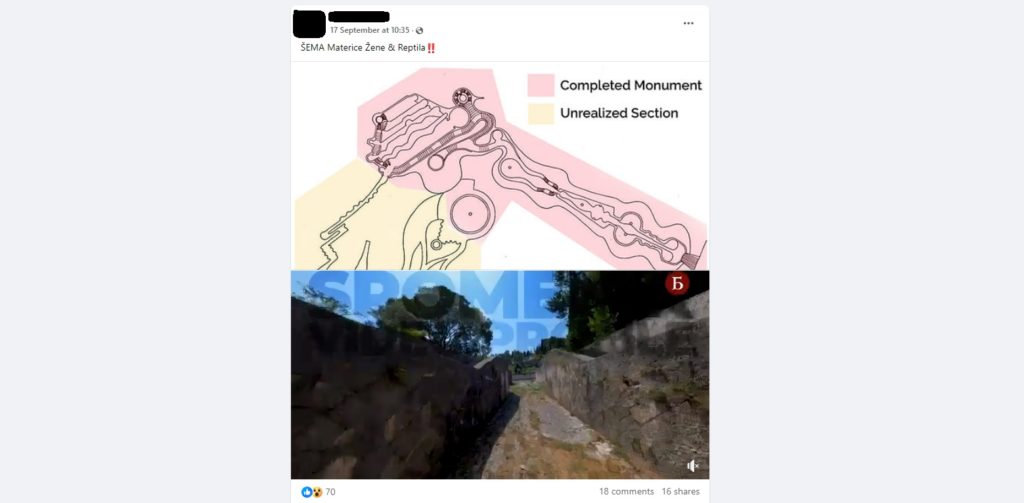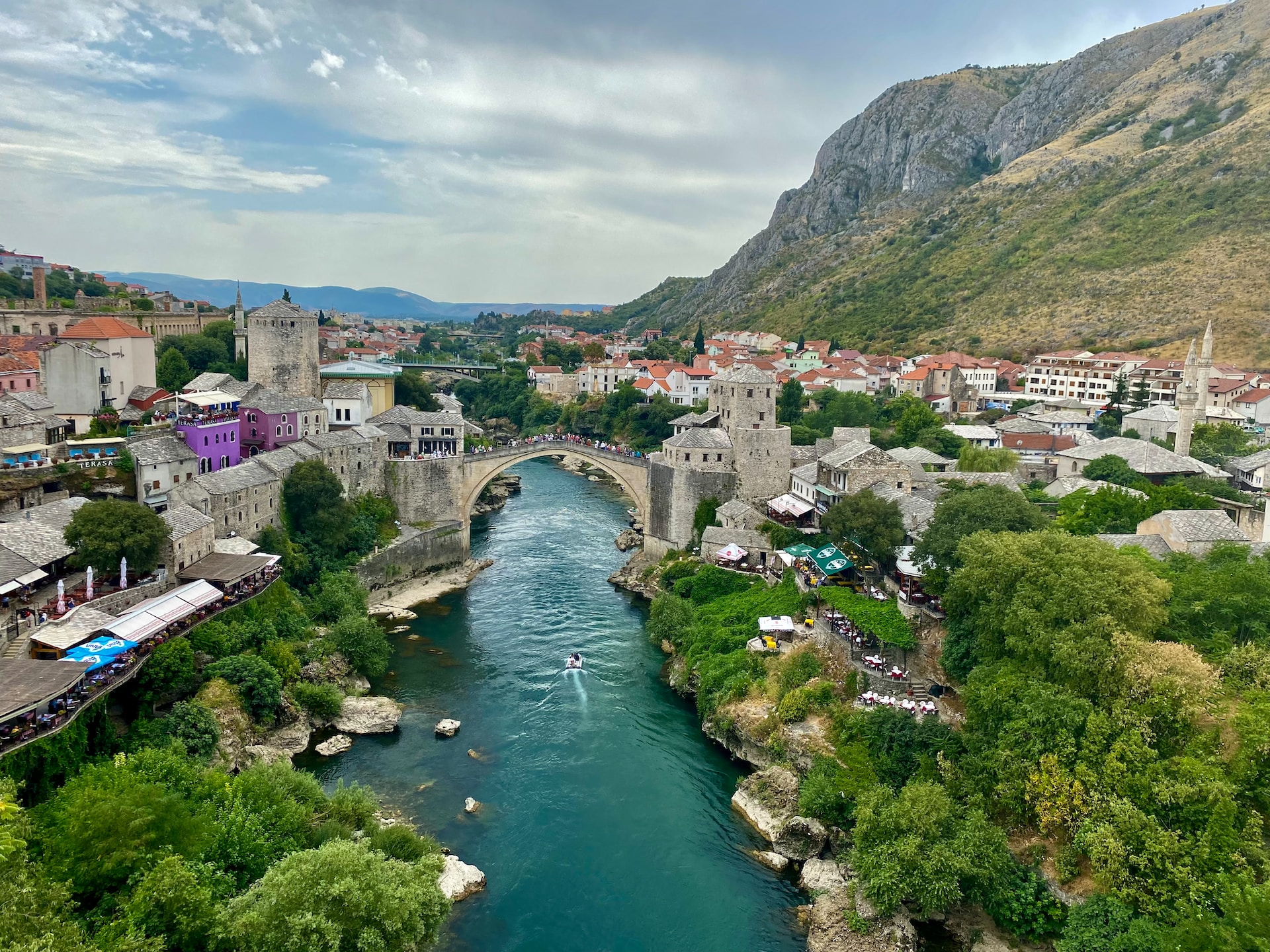Original article (in Croatian) was published on 25/09/2023; Author: Ladislav Tomičić
Architect Bogdan Bogdanovic was invited in 1959 to design a memorial complex for 810 fallen anti-fascists of the Second World War from Mostar.
Conspiracy theory supporters are sharing a post on social networks that contains a short video of the Partisan Cemetery in Mostar and a diagram showing how the aforementioned memorial complex was imagined by its author, Bogdan Bogdanovic.
Conspiracy theorists state in the description that it is a “womb-reptilian scheme” (archived here and here).

Of course, this is nonsense.
Before explaining the symbolism of Bogdanovic’s memorial complex, let’s take a look at the scheme, which, according to conspiracy theorists, represents a woman, that is, a reptilian womb. It is a scheme of the monument complex, which consists of two parts: in red is the part of the project that was realized, and in yellow is the part of the complex that, according to Bogdanovic’s plans, was to be added to the existing one. The only part from the second phase of the project that has been realized is the concrete reservoir for collecting rainwater, located at the foot of the slope on which Bogdanovic’s Partisan cemetery was laid.
How did the architect explain the symbolism of the Partisan Cemetery?
When it comes to symbolism, the author Bogdanovic wrote the following: “While building the Mostar acronecropolis, I was carried away by some deep, inner fire. I performed a not very simple and easy job without nausea and fatigue and, in fact, was overwhelmed by a new concept of life and death. It may be absurd to say, but it was as if I hoped to give some of my secret joy to my ‘new friends’, whose names – Muslim, Serbian, Croatian – were just starting to line up on the terraces of the necropolis. Their little afterlife city, as I promised the families, looked into the very heart of old Mostar and the now-destroyed bridge of Supreme Master Hajrudin, that once most beautiful and daring bridge in the world, a work of divine architectural statics, in front of which little Bogdan was as so tiny. The partisan necropolis was Mostar in miniature, a replica of the city on the river Neretva, its ideal diagram. However, that ideogram of the city, that hieroglyph, and that stone sign were not of insignificant dimensions. It reached the outline of one of the more modest, pre-Balkan, Helladic acropolises. From the entrance, lower gate to the fountain at the top (Quelle, Brunnen) one had to overcome a height difference of twenty or so meters and, winding, stone serpentines, walk uphill for a good three hundred meters. The way up was shown by the water that flowed over the carillon to meet the visitor…”
In the text published in the Mostar news magazine MM, in June 1997, the author also mentioned something about the inspiration for the Partisan Cemetery in Mostar: “The stone allegory of two cities was not carved on one of the rough, rocky hills by chance and without any external incentives western Mostar. The initial formulas were probably offered to me by my then-reading material. Namely, rather vaguely, somewhere between the earth and the sky – at least that’s what the ancient books say – floats the city of Hurqualya, the Sufi counterpart of the Manichean Terrae lucidae, which in Gnostic speculations represented a kind of starting point for imprinting into the world wonderful, naive, but eternal philosophical and cosmo-poetic images. And I believed that the fallen anti-fascist fighters from Mostar, still boys and girls as it were, have, at least symbolically, the right to the beauty of dreams. In the period when the monument was built, i.e. in an already largely peaceful, bureaucratic, and even callous mental and moral environment, from a time perspective of twenty years, the purity of their motives and boundless, naive self-sacrifice could only remind one of the tragic children’s crusades expeditions (Kinderkreuzzuge).”
A group of enthusiasts took Bogdanovic’s “right to the beauty of dreams” as an aegis for an internet site dedicated to his monumental work, where – at partizansko.info – interested parties can get detailed information about the monument complex in Mostar.
What did the architect Masa Celebic write about the Partisan Cemetery?
In a comprehensive article about the Partisan Cemetery published on the web portal specialized in architecture and design “Tristotrojka”, architect Masa Celebic from Podgorica writes: “It was a large complex that needed to overcome a height difference of twenty meters. Using stone from the river Neretva, a long curved gravel path is the beginning that mimics the Mostar roads thus forming a walking path, which is divided into two parts with cascading water in the middle. Paths lead to terraces built on the hillside. On these terraces, there are 630 abstract stone memorial plaques on which the names of the fallen anti-fascists are carved”.
“Sources show that there are many different meanings behind these memorial tablets, some say that they represent freedom and liberation from suffering, while other sources say that the stone tablets are shaped to resemble tree cuts, which would symbolize a break and separation from youth. However, some try to say that the stone slabs are designed in the shape of a flower, which could represent the ‘blooming’ of new life from the earth”, says Niebyl (Niebyl, 2016), writes Celebic in a text from 2019.
The text also states that “Bogdanovic was invited in 1959 to design a memorial complex for 810 fallen anti-fascists of the Second World War from Mostar on Bijeli Brijeg, south of the outskirts of the city”. “Bogdanovic’s goal was to create a necropolis based on the old Etruscan sites in the Middle East (Niebyl, 2016). Necropolis represents the city of the dead versus the city of the living, with the same paved roads, streets and gates, it is a microcosm of the city of Mostar (Mackic, 2015)”, the text reveals.
Therefore, the architect Bogdan Bogdanovic did not build the Partisan Cemetery using the model of the womb of a woman, that is, a reptile, nor is it correct to attribute such a meaning to his work.



